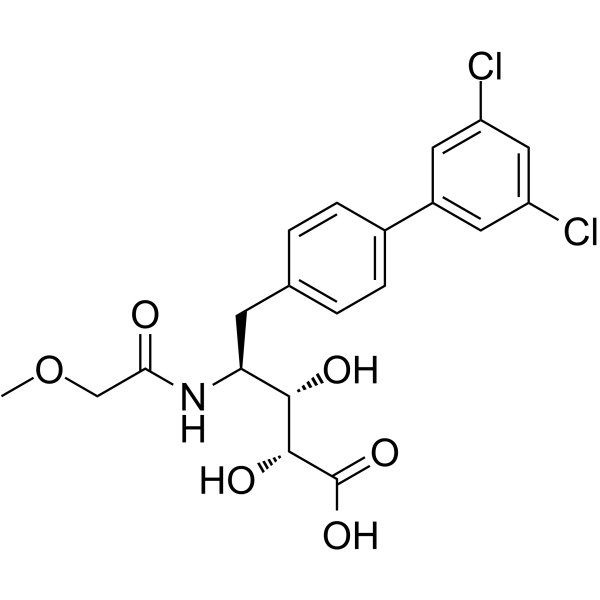上海金畔生物科技有限公司为生命科学和医药研发人员提供生物活性分子抑制剂、激动剂、特异性抑制剂、化合物库、重组蛋白,专注于信号通路和疾病研究领域。
CC0651 纯度: 99.52%
CC0651 是一种人Cdc34泛素结合酶变构抑制剂。CC0651 有效抑制 p27Kip1的泛素化,IC50 为 1.72 μM。

CC0651 Chemical Structure
CAS No. : 1319207-44-7
| 规格 | 价格 | 是否有货 | 数量 |
|---|---|---|---|
| 1 mg | ¥5115 | In-stock | |
| 5 mg | ¥9114 | In-stock | |
| 10 mg | ¥13950 | In-stock | |
| 50 mg | 询价 | ||
| 100 mg | 询价 |
* Please select Quantity before adding items.
CC0651 相关产品
•相关化合物库:
- Bioactive Compound Library Plus
| 生物活性 |
CC0651 is an allosteric inhibitor of the human Cdc34 ubiquitin-conjugating enzyme. CC0651 potently (IC50=1.72 μM) inhibits the ubiquitination of p27Kip1, as confirmed by dose-response analysis. |
IC50 & Target |
IC50: 1.72 μM (p27Kip1 ubiquitination)[1] |
||||||||||||||
|---|---|---|---|---|---|---|---|---|---|---|---|---|---|---|---|---|---|
| 体外研究 (In Vitro) |
CC0651 strongly impairs the rate of ubiquitin chain initiation on substrate by SCFCdc4, as measured by the monoubiquitination of Sic1 by K0 ubiquitin. CC0651 actually potentiates the formation of both ubiquitin dimers and monoubiquitinated hCdc34, concordant with the observed accumulation of the hCdc34 conjugate in cells treated with the ester derivative of CC0651. CC0651 completely inhibits the assembly of polyubiquitin chains and decreased formation of free triubiquitin and, to a lesser extent, hCdc34 monoubiquitin, but has no effect on production of diubiquitin[1]. CC0651 is an inhibitor of the E2 ubiquitin conjugating enzyme Cdc34A, acts by trapping a weak interaction between ubiquitin and the E2 donor ubiquitin binding site. A quantitative SCF ubiquitination assay with a β-Catenin substrate peptide yields a value of IC50 of 18±1 μM for CC0651 inhibition, similar to the effective concentrations observed in the NMR and TR-FRET assays[2]. 上海金畔生物科技有限公司 has not independently confirmed the accuracy of these methods. They are for reference only. |
||||||||||||||||
| 分子量 |
442.29 |
||||||||||||||||
| Formula |
C20H21Cl2NO6 |
||||||||||||||||
| CAS 号 |
1319207-44-7 |
||||||||||||||||
| 运输条件 |
Room temperature in continental US; may vary elsewhere. |
||||||||||||||||
| 储存方式 |
|
||||||||||||||||
| 溶解性数据 |
In Vitro:
DMSO : ≥ 56 mg/mL (126.61 mM) * “≥” means soluble, but saturation unknown. 配制储备液
*
请根据产品在不同溶剂中的溶解度选择合适的溶剂配制储备液;一旦配成溶液,请分装保存,避免反复冻融造成的产品失效。 |
||||||||||||||||
| 参考文献 |
|
| Kinase Assay [1] |
For small-molecule screens, p27Kip1 is ubiquitinated in a 15 μL reaction with 40 nM phospho-p27, 40 nM E1, 5 μM E2, 25 nM SCFSkp2, 25 nM Cks1, and 27.8 μM biotinylated ubiquitin in 40 mM Tris-HCl [pH 7.5], 5 mM MgCl2, 1 mM DTT, and 0.5 mM ATP at 23°C for 3 hr. The reaction is terminated with assay diluent, transferred to 384-well protein A plates coated with 62 ng SC528 antibody, incubated for 1 hr, and washed six times with 10 mM Tris-HCl [pH 7.6], 0.05% Tween20 prior to addition of 25 μL of 0.4 mg/mL europium streptavidin in HEPES [pH 7.6], 1% BSA, 0.2% Tween20 per well. Plates are incubated for 1 hr, washed, and read for Eu-time-resolved fluorescence after addition of 25 μL enhancement solution. For gel-based ubiquitination assays, CC0651 and its analogs are preincubated at the indicated concentrations with 0.5 μg E1, 1-4 μg hCdc34, and 50 ng SCFCdc4, 100 ng SCFFbw7, 150 ng SCFβTrCP, or 50 ng SCFSkp2 for 10-45 min at 4°C in 20 μL reaction buffer (50 mM HEPES [pH 7.5], 10 mM MgCl2, 2 mM ATP, and 50μM DTT). Reactions are initiated by addition of 1μg ubiquitin and respective SCF substrates (50 ng HisSic1 phosphorylated by Cln2-Cdc28, 50ng cyclin E phosphorylated by Cdk2, 25 ng biotinylated IκBα phosphopeptide [KKERLLDDHDpSGLDpSMKDEE], or 50 ng p27Kip1 phosphorylated by cyclin E-Cdk2), incubated at 30°C for 1-3 hr, and products visualized by immunoblot[1]. 上海金畔生物科技有限公司 has not independently confirmed the accuracy of these methods. They are for reference only. |
|---|---|
| Cell Assay [1] |
PC-3 and HCT116 cell lines are grown in DMEM supplemented with Penicillin/Streptomycin, 2 mM glutamine, and 10% fetal bovine serum (FBS). Lentiviral shRNA constructs for human CDC34, UBE2R2, and nontarget control are used. For proliferation assays, PC-3 cultures are seeded at 5000 cells/well in quadruplicate in 24-well plates, grown for 24 hr, and then infected with lentiviral supernatant. For small-molecule inhibition, cells are seeded in quadruplicate at 500 cells/well in 96-well plates, grown for 24 hr, and treated with compound. Proliferation is measured by MTT assay. PC-3 or HCT 116 cultures are synchronized in G0/G1 by serum starvation for 30 hr and then released by addition of 10% serum. For epistasis experiments, PC-3 cells are infected with CDC34 shRNA for 24 hr, followed by addition of inhibitor and assessment of proliferation after 4 days. Anti-Cdc34, anti-p27, anti-α-tubulin, anti-ubiquitin, and anti-cyclin E antibodies are used[1]. 上海金畔生物科技有限公司 has not independently confirmed the accuracy of these methods. They are for reference only. |
| 参考文献 |
|
所有产品仅用作科学研究或药证申报,我们不为任何个人用途提供产品和服务
